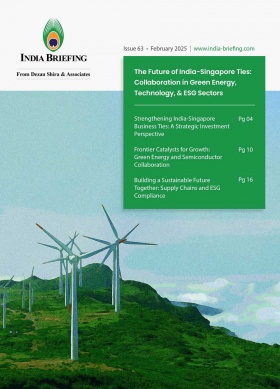India’s M&A Outlook 2025: Domestic Strength and Sectoral Drivers
India’s mergers and acquisitions (M&A) market surged in 2025, driven by domestic deals, new merger control rules, and active private equity. Read about sectors, regulations, and deal value trends.
India’s mergers and acquisitions (M&A) landscape in 2025 reflects an uptick in momentum. With a rise in domestic consolidation, regulatory shifts, and an evolving private equity environment, deal-making has reached a three-year high in value in 2025. During the first quarter of calendar year (CY) 2025, i.e., January to March, India recorded 669 M&A transactions totaling US$29 billion, the highest quarterly volume since Q1 CY 2022 and the largest value since Q3 CY 2022, as per Grant Thornton. Strategic consolidations, particularly in energy, financial services, and digital sectors, are expected to shape the year ahead.
M&A trends and volumes in India’s domestic sector
When excluding Initial Public Offering (IPO) and Qualified Institutional Placement (QIP) activity, 636 deals were registered in Q1 CY 2025, amounting to US$24.4 billion, a 28 percent increase in volume and 34 percent rise in value compared to the previous quarter (Q4 CY 2024). On a year-over-year basis, transaction volume rose by 43 percent and value by 17 percent, underscoring continued investor confidence and a strong appetite for strategic investments.
Domestic mergers and acquisitions accounted for 72 percent of overall deal volumes. Inbound cross-border activity also reached a record high with 27 deals totaling US$2.7 billion. Among them, Wilmar International’s US$1.4 billion acquisition of Adani Wilmar’s staples division marked the largest M&A activity of the year so far. Bajaj Group’s US$2.7 billion acquisition of a 26 percent stake in Bajaj Allianz General and Life Insurance stood out as a major domestic consolidation.
|
M&A type |
Q1 CY 2025 (value in US$ billion) |
YoY change |
|
Total M&A |
27 |
+29.6% |
|
Target India* |
25.3 |
+24.4% |
|
Domestic M&A |
21.6 |
+145.4% |
|
Inbound M&A |
3.7 |
−67.8% |
|
Outbound M&A |
2.1 |
>3x increase |
Source: Business Standards
(*Target M&A refers to potential M&A of suitable companies.)
The sharp contrast between surging domestic deals and weak inbound activity highlights the strength of internal demand.
Sectoral drivers of deal activity
India’s energy and power sector led M&A deal value in Q1 CY 2025, accounting for US$7.3 billion, a 15-fold increase over the previous year. The financial sector followed with US$5.2 billion, up 36 percent, while media and entertainment saw US$4.5 billion in deals, up 15.5 percent.
Private equity-backed M&A activity surged to US$5.3 billion, marking a 227.6 percent increase. Key drivers included green energy investments, infrastructure partnerships, and consolidation in IT services.
Other sectors indicating possible M&A activities are as follows:
- AI and deep-tech: With the central government allocating US$1.25 billion to artificial intelligence (AI) development and companies like Reliance launching proprietary platforms, vertical integration and strategic acquisitions are expected to transpire in 2025.
- Blockchain and crypto: Following acquisitions like CoinDCX’s purchase of BitOasis in 2024, deal-making in this space is expected to grow.
- Insurance: A proposed hike in Foreign Direct Investments (FDI) limits to 100 percent could spur consolidation and capital inflows; and
- Space: New automatic FDI rules for satellite and space activities make this an emerging M&A zone.
M&A transactions shaping 2025
India’s 2025 deal roster includes notable domestic and cross-border transactions. Below are some of the noteable M&A deals:
- Bajaj Group–Bajaj Allianz General and Life Insurance: Acquisition of a 26 percent stake for US$2.7 billion, marking one of the largest domestic consolidations in the insurance sector.
- Brookfield–ATC India Tower Corporation: Brookfield acquired the Indian arm of American Tower Corporation for US$2 billion, expanding its telecom infrastructure presence.
- Tata Consumer Products–Capital Foods: Acquisition of Capital Foods Pvt. Ltd. strengthens Tata’s FMCG brand portfolio in India.
- Wilmar International–Adani Wilmar’s Staples Business: Cross-border acquisition valued at US$1.4 billion, signaling a shift in retail staples positioning.
- Adani Group (multiple acquisitions): The company’s acquisitions include multiple sectors such as green energy, cement, and data center assets.
- Hindustan Unilever—Minimalist: Hindustan Unilever’s acquisition of Minimalist, a personal care brand in India, is valued at US$342 million.
- AM Green Power B.V.–Greenko Energy Holdings: On March 11, 2025, the Competition Commission of India (CCI) approved the acquisition of a stake in Greenko Energy Holdings (GEH) by AMG Green Power B.V. (AMG Power), a newly incorporated entity. The deal is valued at US$1.5 billion.
- Apollo and BC Partners–GFL Environmental: Indian subsidiaries expected to benefit from US$8 billion environmental sector transaction.
These transactions reflect sector diversification, with M&A expanding beyond traditional IT and energy into AI, Software as a Service (SaaS), and branded consumer tech.
Regulatory changes impacting M&A
India’s merger control regime saw major reform with the enactment of the Competition Commission of India (Combination) Regulations, 2024, and the Revised Exemption Rules under the Competition (Criteria for Exemption of Combinations) Rules, 2024. The reforms amended are as follows:
- Deal Value Threshold (DVT): Transactions above INR 20 billion (US$238 million) now require the CCI clearance if the target has significant Indian operations.
- Expanded scope of scrutiny: The DVT captures digital and pharma sector deals that previously escaped review due to asset/turnover exemptions; and
- Revised exemption rules: New factors such as access to commercially sensitive information and portfolio overlaps now determine exemption eligibility for minority stakes.
These measures align India’s merger regime more closely with global standards while simultaneously increasing the complexity of transaction structuring and notification.
READ MORE: Regulatory Framework Governing Mergers and Acquisitions in India
M&A outlook and deal structuring considerations
Looking ahead, M&A deal value is expected to grow from US$110 billion in 2024 to between US$130 and US$160 billion in 2025. With the Reserve Bank of India (RBI) lowering the policy repo rate to 6.25 percent in February 2025 and expected to drop further to 5.75 percent by December 2025 (as per Fitch Ratings), borrowing costs may fall, supporting leveraged deals and consolidation. Nonetheless, geopolitical risks, the US’s reciprocal tariffs, and regulatory developments (India-EU trade deals) remain key variables.
Summary
India’s M&A market in 2025 is marked by rising deal values, regulatory transformation, and resilient domestic consolidation. As new merger control thresholds come into effect and private equity continues to inject capital, strategic buyers must balance opportunity with compliance. Sectoral momentum in energy, AI, crypto, and insurance adds to the outlook.
Dealmakers should engage early with regulatory authorities, update compliance frameworks, and align structuring strategies with emerging rules to maximize execution success in India’s dynamic M&A environment.
(US$1 = INR 84.29)
About Us
India Briefing is one of five regional publications under the Asia Briefing brand. It is supported by Dezan Shira & Associates, a pan-Asia, multi-disciplinary professional services firm that assists foreign investors throughout Asia, including through offices in Delhi, Mumbai, and Bengaluru in India. Dezan Shira & Associates also maintains offices or has alliance partners assisting foreign investors in China, Hong Kong SAR, Vietnam, Indonesia, Singapore, Malaysia, Mongolia, Dubai (UAE), Japan, South Korea, Nepal, The Philippines, Sri Lanka, Thailand, Italy, Germany, Bangladesh, Australia, United States, and United Kingdom and Ireland.
For a complimentary subscription to India Briefing’s content products, please click here. For support with establishing a business in India or for assistance in analyzing and entering markets, please contact the firm at india@dezshira.com or visit our website at www.dezshira.com.
- Previous Article India’s Competition Authority Rolls Out 2025 Cost Regulations Norms
- Next Article India-Belgium Ties Enter New Era of Defense Manufacturing and Scientific Research







